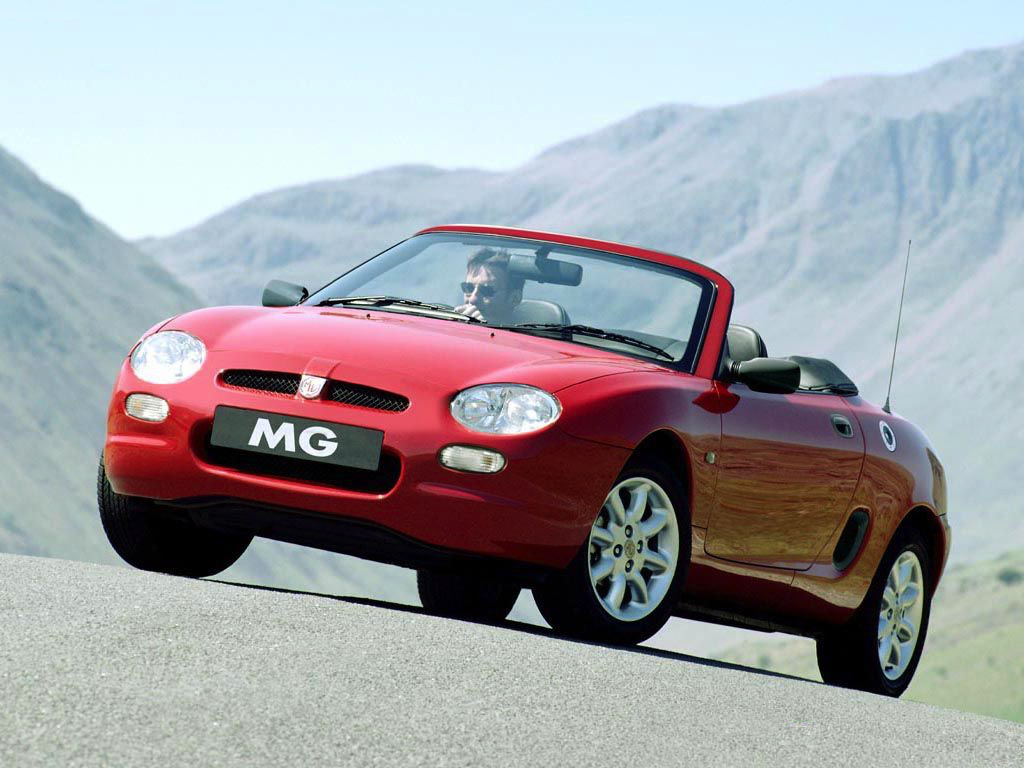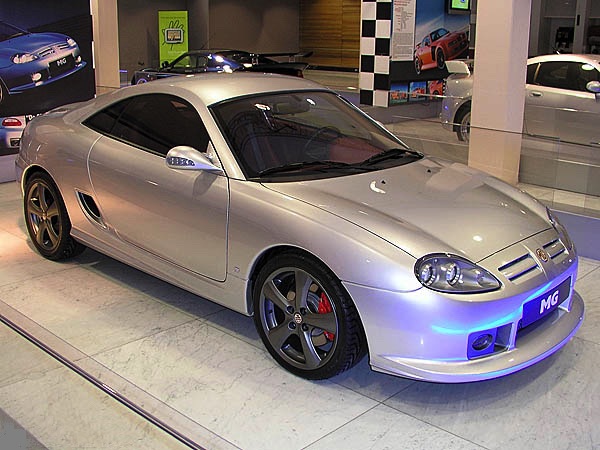MGF & MGTF Model Evolution
 The MGF
and later MGTF are
mid-engined, rear wheel drive roadster cars that
were produced by MG-Rover from 1995 until 2005, and by MG Motor from
2007 until 2011. The MGF was the first car to bear the MG marque since
the MGB that was produced from 1962 to 1980. Production of the MGTF
paused in 2005, when MG Rover went into receivership, and resumed in
2007 under the company's new owners Nanjing of China.
The MGF
and later MGTF are
mid-engined, rear wheel drive roadster cars that
were produced by MG-Rover from 1995 until 2005, and by MG Motor from
2007 until 2011. The MGF was the first car to bear the MG marque since
the MGB that was produced from 1962 to 1980. Production of the MGTF
paused in 2005, when MG Rover went into receivership, and resumed in
2007 under the company's new owners Nanjing of China.
MG had stopped producing sports
cars in 1980 when British Leyland
closed
their Abingdon plant, although the badge of MG was used on
badge-engineered hatchbacks and saloons between 1982 and 1991. In 1992,
the company (by this time Rover Group) restarted production of the
classic MGB as the limited edition RV8, and positive reaction led the
company to develop the MGF.
It was revised and renamed using the historic TF name in 2002, but
production was halted, following the collapse of the MG Rover Group in
April 2005. However, after Nanjing Automobile Group acquired the rights
to the MGTF, the completion of the new factory for MG in Nanjing saw
production being restarted in March 2007.
The MGF was launched in the
Northern Hemisphere autumn of 1995 by the
Rover
Group, making it the third car to be launched since the takeover by
BMW. It was powered by a 1.8L K-series 16-valve engine, the basic
having 120PS (88 kW) while the more powerful VVC (variable valve
control) had 145PS (107 kW). Although popular across Rover's model
range, when fitted to the MGF the K-series engine was plagued by head
gasket failure, often attributed to the more complex nature of cooling
a mid-engine car. Rover did little to address this, with owners
frequently having to meet the cost of expensive repairs themselves
early in the life of their vehicles. Rover Special Projects oversaw the
development of the F's design and before finalising the styling
bought-in outside contractors to determine the most appropriate
mechanical configuration for the new car.
Steve Harper of MGA Developments produced the initial design concept in
January 1991 (inspired by the Jaguar XJR-15 and the Ferrari 250LM),
before Rover's in house design team refined the concept under the
leadership of Gerry McGovern. An interesting feature of the F was its
Hydragas suspension, a system employing interconnected fluid and gas
displacers which provided a surprisingly compliant ride but which could
be tuned to provide excellent handling characteristics.
The MGF quickly shot to the top of the affordable sports car charts in
Britain, and remained there until the introduction of the MGTF in 2002.
The MGF underwent a facelift
in autumn of 1999, and gave the car a
revised interior as well as styling tweaks and fresh alloy wheels
designs. There was also the introduction of a base 1.6 version and a
more powerful 160PS (118 kW) variant called the Trophy 160, which had
a 0-60 mph time of 6.9 seconds. It was only produced for a limited time.
An automatic version with a CVT called the Steptronic was also
introduced. The MGF continued to sell well in spite of the sale of the
Rover Group, which was announced in March 2000. Land Rover was sold to
Ford, while the MG and Rover marques were sold to the Phoenix
consortium for £10. In spite of competition from the likes of Mazda
MX-5, BMW Z3 and Audi TT, the MGF still proved fairly popular.
EXF
Project EXF represents a
limited production of five single-seat MGF
sports cars that allude to historic land-speed records set by MG
between 1930 and 1959. Known simply as the F, the MG car features
largely standard MGF components, a turbocharged 1.4L (329 PS) Rover
K-series engine, and a drag coefficient of less than 0.25. On 20 August
1997, the F achieved a top speed of 217 mph (349 km/h) at the SpeedWeek
festivities in Bonneville, Utah, United States.
MGTF
In 2002, the MGTF was released,
named after the MGTF Midget of the
1950s. Based upon the MGF platform, but heavily redesigned and
reengineered, the most significant mechanical changes were the
abandonment of Hydragas suspension in favour of conventional coil
springs, the new design of the air induction system that along with new
camshafts produces more power than in MGF engines, and the torsional
stiffness of the body increased by 20%.
Various cosmetic changes include a revised grille, redesigned front
headlights, bumpers, side air-intake grills, rear boot, etc.It held a
decent amount of sales despite problems including uneven shut lines on
the drivers door, on models for the United Kingdom. Production was
suspended in April 2005, when MG Rover collapsed.
The MGTF was assessed with four
star safety performance from Euro NCAP
and ANCAP.
In March 2007, Nanjing Automobile
Group, which bought MG Rover's
remaining assets during bankruptcy proceedings, restarted production of
the MGTF at its Nanjing factory, with a capacity of 200.000 cars a
year. Experts from the Longbridge factory were involved in
building the new TFs in Nanjing.
In August 2008, more than three years after the facility had closed due
to the bankruptcy of MG Rover, assembly of a lightly revised MGTF
model for the European market, from Chinese built complete knock down
(CKD) kits, was started by NAC MG UK at Longbridge.
The first TF model to be produced by NAC MG UK was the TF LE500. As
the name suggests, this was a limited edition of five hundred cars each
individually numbered. The better suspension set-up and the heated rear
window from the 2005 model TF were carried over to the LE500. Styling
was reminiscent of the original MGF, with an intake on either side of
the MG badge, and a large single intake below the license plate.
The LE500 specification includes leather seats, hard top and soft top,
wind stop, CD tuner with MP3 compatibility, rear parking sensors,
sixteen inch eleven spoke alloy wheels, and front fog lights. The LE500
was followed by the model TF 135 and a further limited
edition TF 85th Anniversary, of which only fifty were ever produced.
Production of the TF at Longbridge was suspended again in October 2009,
due to low demand in face of the recession. Production resumed in
the new year, but the end of production was finally announced in March
2011, due to lack of demand and component supply problems. A total of
922 TFs were produced at Longbridge under Chinese ownership.
Concept Cars
XPower 500
Created by the XPower
division of the MG Rover Group in 2001 as a one
off to show the brand new XPower division and also to show what the
engineers could do. The car was designed to accommodate the brand new
XP-20 engine used in the MG-Lola EX257 race car with a Garrett
turbocharger with an anti-lag system which achieves 500PS. The Power
then goes through a 6 Speed sequential gearbox manufactured by X-Trac.
When built in 2001, the car was equipped with several upgrades over the
standard car. It featured a seam welded bodyshell with a fully
integrated T45 roll cage with strengthened subframes. The chassis comes
complete with a Limited-slip differential, independent racing
suspension and upgraded 4-Pot AP Racing Brakes. The car has 17"
multi-spoke alloy racing wheels with 225/13 R17 tyres (front),
265/13 R17 tyres (rear) and a bespoke rear wing.
Initially the XPower concept was designed for a brand new wild version
of the MGTF, this never came around however and no concept car for a
production XPower TF was created. Reportedly the car was set to feature
a de-tuned XP-20 engine used in the XPower 500 concept and the MG-Lola
race cars with around 300PS but the idea wasn't developed beyond the
planning stage.
MGTF GT
 Designed
in 2005, at Dove in
Norfolk by Peter Stevens and his team, at
the same time as the Rover 75 Coupé, is the coupe MGTF, called the GT,
similar to the Pininfarina designed MGB GT. It was unveiled before MG
Rover Group collapsed in April 2005, and was shown at several events
such as the AutoRAI in Amsterdam, alongside other cars such as the MG
XPower SV.
Designed
in 2005, at Dove in
Norfolk by Peter Stevens and his team, at
the same time as the Rover 75 Coupé, is the coupe MGTF, called the GT,
similar to the Pininfarina designed MGB GT. It was unveiled before MG
Rover Group collapsed in April 2005, and was shown at several events
such as the AutoRAI in Amsterdam, alongside other cars such as the MG
XPower SV.The concept car was developed from a top of the range TF 160, and came with a grenadine interior (a rare option typically in the top of range TF's), brand new lowered bucket seats, 17" OZ five spoke wheels, a front splitter to improve aerodynamics and for the first time in a production/factory TF a 2.5L Rover KV6 engine. It was reported on forums for MG that the engine was changed to a standard 160 VVC 1.8L K-series sometime in 2005, although this is disputed and is also disputed as to whether the car received a KV6 in the first place.
When launched the car proposed several problems. The first of the problems with the coupe is engine access which because the car is a mid rear arrangement proposed several problems and made the car hard to work on, it is reported that the subframe had to be removed in order to work on the engine. The second problem is the KV6 powerplant which had to have a bespoke smaller fuel tank to fit in the engine bay as the standard fuel tank wouldn't fit, although disputed as to whether the car received the KV6 powerplant in the first place.
Former engineers at MG Rover reported that the car was close to entering production, and as soon as the end of 2005, the car could have been sold. However MG Rover went into receivership, and progress was halted. Nanjing were set to revive the idea and manufacture in the US in a brand new factory in Oklahoma employing 500 people. This idea also never came about with the LE500 and TF135 being the only TF produced by Nanjing at Longbridge, rather than a new purpose built facility in Oklahoma.
Reception
Throughout its production, the MG sold successfully. In a number of road tests, the MGF impressed, and was a match for its main rivals the Mazda MX-5 and BMW Z3 in terms of handling, performance and practicality, but build quality, reliability and dealer support within the United Kingdom were poor in comparison to its Japanese and German rivals.
However, after Nanjiing took over and restarted production, the car's sales plummeted, until production was eventually ceased in March 2011.
Parker's gave the car 2.5/5 and said its pros were "Styling, handling and brand heritage" and cons were "Dated interior, patchy build quality and poor reliability".
What Car? gave it 2/5 saying its pros were that it is "pretty and affordable" but its cons were "The driving position and steering are not what you'd expect in such a sporty car".
Auto Express reviewed it after Nanjiing took over, and also had a verdict of 2/5, liking how it was "well equipped and compact" but disliking how it was priced more expensive than a basic Mazda MX-5, stating it has "barely changed since 1995, and can be mistaken for a much older vehicle" and also commenting on its cramped interior.
The engine of K-series used in the MGF has gained a reputation for head gasket failure. This is mainly due to the design and placement of the thermostat, however the installation of the headgasket was also a major factor. Other factors include insufficient width between the cylinders, build tolerances, block face stiffness, casting quality, gasket material, and cooling system layout (the engine is at the back and the radiator is at the front).
Due to the placement of the thermostat on the intake side of the water pump at the base of the block the head can overheat before sufficient heat is transmitted through the block to allow the thermostat to open. Thermal shock from cooling the block rapidly and the thermostat closing abruptly due to cold water from the radiator cooling the opening spring can result in insufficient coolant reaching as far as the head, which can cause different expansion and contraction rates between the head and the block.
This combined with the early practice of installing the head gasket with plastic locating dowels, which subsequently melted when the engines overheated, allowed the head gaskets to "walk". A redesigned head gasket, which consists of a multiple layer metal gasket or "MLS" used in conjunction with steel locating dowels, is alleged to significantly reduce the chance of a head gasket failure.
There is no replacement engine that is a suitable replacement for the motor of K-series. Apart from the head gasket problem, MGF and TF models are said to have few major faults.
The engine for the K-series was sourced from the existing Rover line and was mainly intended as a front engined commuter vehicle power source. The design compromise of locating the thermostat on the pump intake rather than the head outlet originates in this original use. A common aftermarket modification by those who intent to drive their MGFs spiritedly is to install an Inline thermostat in the outlet pipe from the head to the radiator. This head gasket problem is also found on K-series engined Lotus Elises and is also commonly solved by thermostat relocation.